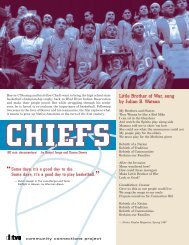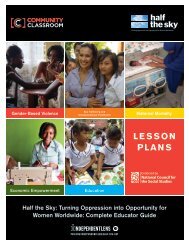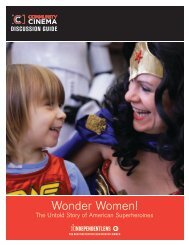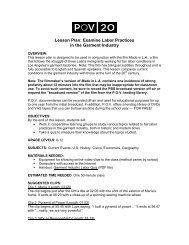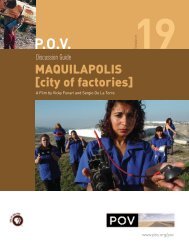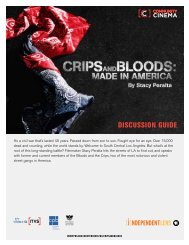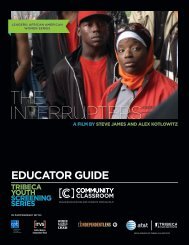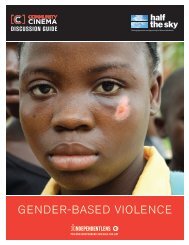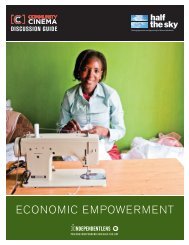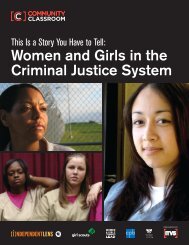Download Lesson Plan (PDF) - FutureStates
Download Lesson Plan (PDF) - FutureStates
Download Lesson Plan (PDF) - FutureStates
- No tags were found...
Create successful ePaper yourself
Turn your PDF publications into a flip-book with our unique Google optimized e-Paper software.
COMMUNITY CLASSROOM: SEEDCOMMUNITY CLASSROOMIndependent Television Service (ITVS)651 Brannan Street, Suite 410San Francisco, CA 94107E-mail: outreach@itvs.orghttp://www.itvs.org/classroomCOMMUNITY CLASSROOM is an innovative education resource providing short documentary videocontent and accompanying curricular materials, lesson plans, and homework assignments to high schooland community college instructors and youth-serving community-based organizations. Film modules aredrawn from documentaries scheduled for broadcast on the Emmy Award-winning PBS series IndependentLens. Content is grouped into subject specific segments that correspond to lesson plans and educationalactivities. All COMMUNITY CLASSROOM lesson plans are designed with key education standards in mind,and are available free of charge online, along with the film modules.COMMUNITY CLASSROOM is a program of the Independent Television Service, created with support fromthe Corporation for Public Broadcasting. <strong>Lesson</strong> plans were developed with guidance from the AmericanAssociation of Community Colleges, KQED Education Network, National Association for Media LiteracyEducation, National Council for the Social Studies, National State Teachers of the Year, and PBS Teachers.© Copyright 2010Independent Television Service (ITVS)
COMMUNITY CLASSROOM: SEEDThe Future of Genetic Engineering<strong>Lesson</strong> <strong>Plan</strong> OverviewTopics CoveredBiological diversity; genetic engineering; environmental balance; natural and human-induced hazards;population growth; science and technology in local, national, and global levels challenges.Target AudienceGrade 9 Biology, Environmental Science with modifications for Grade 10-12 Advanced, AP or Dual creditBiology or Environmental Science. This lesson is designed to follow instruction in biotechnology and requiressome familiarity with agricultural GMOs.National Educational StandardsAll components are aligned to the National Science Education Standards as presented by the NationalAcademy of Science and available as a free download at: http://www.nap.edu/catalog/4962.The lesson addresses the following standards:NS.9-12.1 SCIENCE AS INQUIRYAs a result of activities in grades 9-12, all students should develop• Understandings about scientific inquiryNS.9-12.3 LIFE SCIENCEAs a result of their activities in grades 9-12, all students should develop understanding of• Molecular basis of heredity• Interdependence of organismsNS.9-12.5 SCIENCE AND TECHNOLOGYAs a result of activities in grades 9-12, all students should develop• Understandings about science and technologyNS.9-12.6 PERSONAL AND SOCIAL PERSPECTIVESAs a result of activities in grades 9-12, all students should develop understanding of• Environmental quality• Natural and human-induced hazards• Science and technology in local, national, and global challengesNS.9-12.7 HISTORY AND NATURE OF SCIENCEAs a result of activities in grades 9-12, all students should develop understanding of• Science as a human endeavor• Nature of scientific knowledge• Historical perspectivesIn addition to the National Standards for Science, the lesson plans provide an excellent framework forinstruction in Media Literacy. This instruction further supports both NS.9-12.1 SCIENCE AS INQUIRY andNS.9-12.7 HISTORY AND NATURE OF SCIENCE by instructing students in methods that will make themmore effective in media analysis. Information on Media Literacy can be found at www.NAMLE.net .TimeEach lesson is designed for a 45-55 minute class period. The modules may be separated or combined toaccommodate differences in instructional time. The entire unit is designed to be completed in four days.FUTURESTATES.TV PAGE 1
COMMUNITY CLASSROOM: SEEDOverview of SeedIn an industry dominated by genetically modified seeds, a poor farmer struggles to survive. When he resortsto smuggling now-illegal organic seeds across borders, he risks everything.Summary of <strong>Lesson</strong>The lesson reviews the history of agricultural biotechnology. Students will propose a new GMO productbased on need, potential for profit, and minimal environmental effects. After the film is shown, studentswill be asked to consider a future similar to the one depicted in the film. Students are invited to make aprediction concerning the future use of GMOs. They will then investigate the predictions on the Predict-O-Meter, which is located on the FUTURESTATES website. Students are encouraged to add a prediction oftheir own design. Students will conclude the lesson by responding to a writing prompt.Background BriefThis is information for the teacher. It includes information about agricultural biotechnology that may help youguide your students as they contemplate the future status of GMOs.DefinitionsBefore investigating the development of genetically modified foods, it is important to understand thedifferences between conventional, organic, and genetically modified foods. Throughout history, conventionalfarming and organic farming have been virtually the same. It wasn’t until the development and subsequentwide-spread use of inorganic pesticides and herbicides during the mid-twentieth century that agriculturemoved away from organic farming techniques. Conventional farming differs from organic farming in its use ofsynthetic chemicals to enhance either the product itself or the productiveness of the product. Conventionalfarming utilizes herbicides, pesticides, fertilizers, and selected hormones to improve plant production. Routineuse of antibiotics and growth hormones is also employed in the raising of animals for human consumption.Organic farming generally prohibits the use of any inorganic pesticides, insecticides, or herbicides in theproduction of the food. Organically raised food is virtually free of antibiotics, growth hormones, and residualinorganic pesticides or herbicides. By definition, the genome is also free of any contaminants. This definitionprecludes the possibility of organic GMOs: although GMOs can be grown organically, the USDA does notcertify them as organic foods. Genetically modified foods may be raised either conventionally or organically.The distinction is in their genome. GMOs contain bits of other organisms’ DNA and are often termed“transgenic.”Selective BreedingHumans have been engaged in selective “engineering” for thousands of years. The selective crossing ofone individual with another to produce a desired trait in an offspring has been the basis for the developmentof the many breeds of domesticated plants and animals. In the past, the success or failure of an individualcross was largely a matter of chance, as explained by Mendel and other geneticists. Today, selectivebreeding occurs at the molecular level with the direct transfer of desired DNA from one organism to another.Bioengineering produces organisms with modified genomes. As a result, they are most often referred to asGMOs (genetically modified organisms).FUTURESTATES.TV PAGE 2
COMMUNITY CLASSROOM: SEEDPrecautionary PrincipleIn 1998, the Precautionary Principle was presented as a proposed basis for future environmental and publichealth policy. In effect, it stated that when the health of humans or the environment was at stake, it was notalways necessary to wait for scientific proof before taking protective actions. In other words, it followed theold adage “it is better to be safe than sorry.” The Precautionary Principle is based on the ethical assumptionthat humans have the responsibility to protect, preserve, and restore the global ecosystem. It also puts theburden of proof that the action is harmless on those taking the action. Future development and cultivation ofagricultural GMOs may be approved or prohibited based on this policy.Commercial Production and Identification of GMOsWeb ResourcesFor more information on genetic transfer, PCR, and bioengineering:http://www.hhmi.org (Click on “Biointeractive,” then choose “Animation”)http://wwwdnalc.orgFor more information on Bt corn and Roundup Ready Soybeans:http://www.ars.usda.gov/is/br/btcornhttp://www.ca.uky.edu/entomology/entfacts/ef130.aspFor more information on organic foods:http://www.organic.orghttp://www.organicfoodinfo.netFor more information on the Precautionary Principle:http://www.sehn.orghttp://www.precaution.orghttp://www.pprinciple.net/the_precautionary_principle.htmlAdditional information is available in most advanced biology textbooks.FUTURESTATES.TV PAGE 4
COMMUNITY CLASSROOM: SEED<strong>Lesson</strong> 1ObjectivesStudents will:• Identify selected GMOs and describe the technology used in the development of theproducts.• Relate the intended benefits associated with the use of the products.• Recognize and discuss the potential problems associated with the products.• Discuss the contrasts between the intended benefits and the potential problemsassociated with developing the products, and consider the precautionary principle.• Propose and defend the development of an agricultural GMO. (Students will designtheir own.)• Make predictions pertaining to the development of their proposed GMOs.Materials• A “Grapple” or other example of an enhanced agricultural product• Proposed Product Worksheet (see page 11)• Ticket Out worksheet (see page 13)Beginning (10-12 minutes)Begin with a whole class discussion. Show students a “Grapple” (a Grapple is a grape-flavoredapple: http://www.grapplefruits.com/index.html). Explain the product. Ask students to determineif this is an example of genetic engineering. Discussion will lead to the conclusion that it is not.It is an enhanced product. Why would a company want to know about the popularity of a grapeflavoredapple? Could this be a GMO product in the future? What might be some problemsassociated with the development of this or any other genetically modified apple? Just becausewe can do this, should we? Introduce or re-teach the precautionary principle and the ethics ofaltering the genome of a species.Middle (30 minutes)Organize students into teams of 3-4. Their task is to prepare a proposal for a new GMO. Theymust be prepared to address the potential benefits and risks associated with the product.Distribute the Proposed Product Worksheet. Each team will present and defend their proposal tothe class. This is a brainstorming/critical thinking exercise and if possible should not be extendedbeyond the class period.Suggested development time: 10-15 minutesPresentations: 2-3 minutes/groupTimes will vary according to class size and ability.End (5-7 minutes)End the class using the “ticket out” strategy. This strategy asks students to answer one questionon a worksheet as their “ticket” out of the classroom (see supplemental documents for theTicket Out Worksheet). Ask students the following question: “Of the products proposed by theclass, which one do you believe is most likely to be developed? When do you think we couldmake this product (1 year, 5 years, 10 years, beyond 10 years)?” The answers will provides aquick, informal assessment that checks for understanding and permits the instructor to re-directteaching if necessary. Additional information on the “ticket out” strategy may be found at:http://teachingstrategies.pbworks.com/Ticket-Out-the-DoorAssessment• Responses during discussions.• Ticket Out responsesFUTURESTATES.TV PAGE 5
COMMUNITY CLASSROOM: SEEDExtension Activities andModifications<strong>Lesson</strong> 1This lesson can easily be extended over two days. This may be particularly desirable if the students strugglewith the brainstorming part of the activity. Also, larger classes may not have time to present their proposedproducts. A suggested modification would be to develop the product proposal on day one and present theproposed GMOs on day two. With the additional time, the presentations could be videotaped or presentedas PowerPoint presentations. An extension of time would permit multiple classes to view each other’spresentations and analyze the presentations using the “key questions” presented by the National Associationfor Media Literacy Education at www.NAMLE.net. This would provide the students with practice in analyzingmedia messages.<strong>Lesson</strong> 2If the students have not previously been instructed in media literacy, this lesson could begin with anintroduction to media literacy.If time is an issue for the teacher, the film could be used as enrichment to support instruction inbioengineering. It can also be paired with the FUTURESTATES film Mr. Green as enrichment to accompanya unit on biotechnology.<strong>Lesson</strong> 3It may be desirable to simply investigate the Predict-O-Meter site. Students may explore the site withoutformal evaluation or development of predictions.Additional <strong>Lesson</strong>sIf desired, the unit may include additional time to explore some of the ethics associated with controlling thefood supply. Students may investigate a current issue by reading articles from opposing viewpoints and thendiscussing the information with the class. Example: Monsanto’s proposed use of GMO alfalfa.Suggested websites:USDA/Monsanto GE alfalfa (June 2010)http://www.reuters.com/article/idUSN232672520100623http://healthfreedoms.org/2010/03/01http://action.fooddemocracynow.orgGeneral current topics (updated)www.foodsafetynews.comwww.usda.gov/documents/BIOTECHNOLOGY.pdfThis unit may also include a response to a writing prompt. Information for creating writing rubrics may befound at:• AP 9-point rubric: http://www.englishcompanion.com/pdfDocs/aprubricjago.pdf• Sample Six Traits rubrics: http://educationnorthwest.org/resource/464• Templates for personalized rubrics: http://rubistar.4teachers.orgFUTURESTATES.TV PAGE 9
COMMUNITY CLASSROOM: SEEDSuggestions for the prompt include, but are not limited to:Could exclusive use of high yield, high quality genetically-modified seed actually safeguard the worldagainst famine, or would it ensure a future food shortage? Support your answer.Do you think a world like the one depicted in Seed could ever come to be?Currently, most of Europe is against genetically-modified food. Do you think the logic presented in Seedcould lead to such a profound change of opinion in America concerning the use of GMOs?In the film, the use of genetically modified seed is not merely encouraged, but required, while heirloomseeds are outlawed. Why? Who is benefiting from this law? How could such a law come into being?FUTURESTATES.TV PAGE 10
COMMUNITY CLASSROOM: SEEDProposed Product WorksheetCompany name:R & D Team members:Proposed product (GMO or its name): ________________________Needs Assessment for Product (Who would benefit from the development of the product?):Production Techniques (How would you make the product?):Potential Concerns (Just because it can be done, should it? What or who might be affected by thedevelopment of this product?):Public Relations (How would you market your product?):FUTURESTATES.TV PAGE 11
COMMUNITY CLASSROOM: SEEDQuestion Guide for SeedBefore watching the film, read through the following questions. Use the guide to help you take notes andorganize your thoughts during and after viewing the film.1. At the beginning of the film, Juan is using a device to verify the purity of the plants. What do you think thedevice is detecting? Why do you think that?2. What is the reason for the exclusion of all non-engineered seed? Does the film ever tell you the reason?3. How is the future status of agricultural GMOs depicted in the film different from the current status ofgenetically modified food?4. What is significant about the use of a monarch butterfly to detect “pure” seed? Would everyone viewingthe film understand the significance of the monarch?5. Who is this movie targeting with its message? How do you know?6. What other youth group did the “Sprouts” remind you of? What did the filmmaker use to make thatconnection in your mind?7. The source of the “heirloom seed” was a Native American. Do you think the filmmaker was trying toexpress anything with that choice, or was it just a coincidence?8. Is the premise of this film plausible? Do we have the technology to create the world depicted in the film?FUTURESTATES.TV PAGE 12
COMMUNITY CLASSROOM: SEEDExtension Activity:Predict-O-Meter Evaluation FormFUTURESTATES Predict-O-Meter Activity InstructionsLog on to www.futurestates.tv. Go to the Predict-O-Meter. There are three rows of predictions. The row onthe far left contains the predictions based on the FUTURESTATES films, including Seed. The center rowconsists of predictions submitted by viewers. The far right row contains dates of known events. For thisactivity, click on the green FUTURESTATES predictions. The number that appears in each green square isthe number of predictions related to the specified year. Be certain to scroll down to see all predictions for agiven year. At the end of each prediction is the tag for the film associated with each prediction. Find as manypredictions as you can for the Seed film. Choose three predictions to evaluate using the FUTURESTATESPredict-O-Meter Evaluation Form below. When the assigned evaluations are finished, create at least oneprediction of your own. Your prediction will be evaluated by another student. If the evaluation is at least a “3”,you may post it on the FUTURESTATES website.Film:_________________________Year: ______________Prediction: _________________________________________________________________________________________No1Somewhat2Yes3Don’t know0Is the prediction based on scientific possibilities?Do the consequences of the prediction support the film?Does the prediction directly lead to the next prediction?Do known events in the past support the prediction?Is this prediction plausible? (This is your opinion.)Total: (add column)Overall Total: (Add totals for each column together) __________Score: Overall Total = __________5Film:_________________________Year: ______________Prediction: _________________________________________________________________________________________No1Somewhat2Yes3Don’t know0Is the prediction based on scientific possibilities?Do the consequences of the prediction support the film?Does the prediction directly lead to the next prediction?Do known events in the past support the prediction?Is this prediction plausible? (This is your opinion.)Total: (add column)Overall Total: (Add totals for each column together) __________Score: Overall Total = __________5FUTURESTATES.TV PAGE 14
COMMUNITY CLASSROOM: SEEDFilm:_________________________Year: ______________Prediction: _________________________________________________________________________________________No1Somewhat2Yes3Don’t know0Is the prediction based on scientific possibilities?Do the consequences of the prediction support the film?Does the prediction directly lead to the next prediction?Do known events in the past support the prediction?Is this prediction plausible? (This is your opinion.)Total: (add column)Overall Total: (Add totals for each column together) __________Score: Overall Total = __________5Personal prediction for ____________________________________________________________ (film name)Name: __________________________________Evaluator: _____________________________________Year: ___________________________________Prediction: ____________________________________________________________________________________No1Somewhat2Yes3Don’t know0Is the prediction based on scientific possibilities?Do the consequences of the prediction support the film?Does the prediction directly lead to the next prediction?Do known events in the past support the prediction?Is this prediction plausible? (This is your opinion.)Total: (add column)Overall Total: (Add totals for each column together) __________Score: Overall Total = __________5Should this prediction be posted to the website? ________________Teacher’s approval ________________Date posted ________________If not posted, explain the reason for declining.FUTURESTATES.TV PAGE 15
COMMUNITY CLASSROOM: SEEDLESSON PLAN CREDITSCURRICULA WRITERKathie HilbertA 23 year veteran of teaching, Kathie L. Hilbert is currentlythe Science Chair at Connersville High School in Connersville,Indiana. Ms. Hilbert has both a BA (University of Evansville)and MAT (Miami of Ohio) in Biology. Ms. Hilbert has taughtall levels of Biology and Earth Science, as well as Botanyand Geology. She has also accompanied and supported herstudents on several summer Marine Biology programs heldin Hawaii. Ms. Hilbert has written and developed curriculumfor Botany, Geology, and Early College Earth Science as wellas revised curriculum for other classes. She has also writtencurriculum for community Science Outreach Programs andwas a Science Ambassador for the CDC (writing lesson plansfor their website). Ms. Hilbert was Fayette County’s Teacherof the Year in 2001 when she also successfully attainedNational Board Certification in science teaching.CONTENT MANAGERAnnelise WunderlichITVSAbout FUTURESTATES:Imagining tomorrow’s America today, FUTURESTATES is aseries of independent mini-features — short narrative filmscreated by experienced filmmakers and emerging talentstransforming today’s complex social issues into visions aboutwhat life in America will be like in decades to come. The firstseason of FUTURESTATES debuted in March 2010, and isavailable online at futurestates.tv.About ITVS:The Independent Television Service (ITVS) funds andpresents award-winning documentaries and dramas on publictelevision, innovative new media projects on the Web and theEmmy Award-winning weekly series Independent Lens onTuesday nights at 10 PM on PBS. ITVS is a miracle of publicpolicy created by media activists, citizens and politiciansseeking to foster plurality and diversity in public television.ITVS was established by a historic mandate of Congressto champion independently produced programs that takecreative risks, spark public dialogue and serve underservedaudiences. Since its inception in 1991, ITVS programs haverevitalized the relationship between the public and publictelevision, bringing TV audiences face-to-face with the livesand concerns of their fellow Americans. More informationabout ITVS can be obtained by visiting itvs.org. ITVS isfunded by the Corporation for Public Broadcasting, a privatecorporation funded by the American people.CURRICULUM ADVISORSJenny BradburyPBS TeachersKara ClaytonNational Association for Media Literacy EducationJoseph FathereeNational State Teachers of the YearJohn GoldenNational Council of Teachers of EnglishMatthew LappéAlliance for Climate EducationLESSON PLAN DESIGN AND LAYOUTWilson LingITVSEDITORIAL REVIEWLuke SykoraITVSFUTURESTATES.TV PAGE 16




